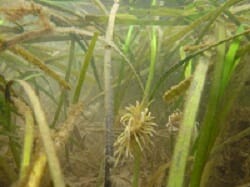The research, which uses novel stereo video technology, has been assessing the fish communities and their age ranges in different habitats around Wales.
Specific focus has been on trying to understand the value of seagrass meadows, kelp forests and horse mussel beds for supporting juvenile fish, particularly those species of commercial importance.

The research was carried out by members of the Seagrass Ecosystem Research Group, at the College of Science, Swansea University and was conducted in collaboration with SEACAMS, the Countryside Council for Wales, the Pen Llyn a’r Sarnau SAC, and the National Trust.
It has resulted in the creation of a publically available short film accessible on the internet. The film is available at the group website.
Studies were conducted around the coast of Pembrokeshire and the Llyn Penninsula and were co-funded by the Welsh Government Ecosystem Resilience and Diversity Fund and the ERDF funded SEACAMS project.
Explaining the background to research, the project leader Dr Richard Unsworth said: “In the UK we are trying to develop a vitally important network of marine protected areas. Making decisions about their proposed exact locations requires making reasoned judgements as to the relative value of different habitat types. Due to the difficulties in sampling many sensitive habitat types without being destructive, we don’t know enough about how threatened habitats such as seagrass, kelp and horse mussel provide support for juvenile fish such as Cod, Pollock and Whiting.
"Researchers at Swansea University used a combination of Baited Remote Underwater Video systems and traditional beach seine netting to quantify the fish species present in seagrass, horse mussel and kelp. These are three habitat types that have all been degraded and disturbed over time, and continue to be under threat in Wales and throughout the UK.”
Dr Unsworth explained the results of the work conducted by the whole team. He said: “Our studies provided evidence of the value of sensitive coastal habitats for supporting economically important fisheries. Our results clearly show how seagrass is important as a juvenile habitat. This was particularly the case for seagrass meadows that contained juvenile fish of at least 10 commercially important species (Cod, Pollock, Whiting, Bass, Mullet, Bass, Plaice, Saithe, Bib, Brill).”
He added: “We all too commonly think of biodiversity conservation as being an activity that is in conflict to industry. But our research is beginning to show that conservation of sensitive coastal habitats in the UK is as much about supporting the fisheries industry as it is about protecting biodiversity.”


